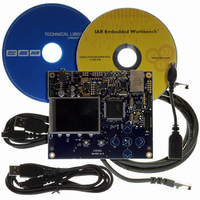ATEVK1105 Atmel, ATEVK1105 Datasheet - Page 21

ATEVK1105
Manufacturer Part Number
ATEVK1105
Description
KIT EVAL FOR AT32UC3A0
Manufacturer
Atmel
Series
AVR®32r
Type
MCUr
Datasheets
1.ATAVRONE-PROBECBL.pdf
(16 pages)
2.ATEVK1104.pdf
(826 pages)
3.ATEVK1105.pdf
(28 pages)
Specifications of ATEVK1105
Contents
Evaluation Board, Software and Documentation
Processor To Be Evaluated
AT32UC3A0512
Processor Series
AVR
Data Bus Width
32 bit
Interface Type
USART, TWI, USB, SPI, Ethernet
Operating Supply Voltage
3.3 V
Silicon Manufacturer
Atmel
Core Architecture
AVR
Core Sub-architecture
AVR UC3
Silicon Core Number
AT32UC3A0512
Silicon Family Name
AVR
Kit Contents
Board CD Docs
Rohs Compliant
Yes
For Use With/related Products
AT32UC3A0
Lead Free Status / RoHS Status
Lead free / RoHS Compliant
- Current page: 21 of 826
- Download datasheet (20Mb)
9. Processor and Architecture
9.1
9.2
32058J–AVR32–04/11
AVR32 Architecture
The AVR32UC CPU
This chapter gives an overview of the AVR32UC CPU. AVR32UC is an implementation of the
AVR32 architecture. A summary of the programming model, instruction set and MPU is pre-
sented. For further details, see the AVR32 Architecture Manual and the AVR32UC Technical
Reference Manual.
AVR32 is a new, high-performance 32-bit RISC microprocessor architecture, designed for cost-
sensitive embedded applications, with particular emphasis on low power consumption and high
code density. In addition, the instruction set architecture has been tuned to allow a variety of
microarchitectures, enabling the AVR32 to be implemented as low-, mid- or high-performance
processors. AVR32 extends the AVR family into the world of 32- and 64-bit applications.
Through a quantitative approach, a large set of industry recognized benchmarks has been com-
piled and analyzed to achieve the best code density in its class. In addition to lowering the
memory requirements, a compact code size also contributes to the core’s low power characteris-
tics. The processor supports byte and half-word data types without penalty in code size and
performance.
Memory load and store operations are provided for byte, half-word, word and double word data
with automatic sign- or zero extension of half-word and byte data. The C-compiler is closely
linked to the architecture and is able to exploit code optimization features, both for size and
speed.
In order to reduce code size to a minimum, some instructions have multiple addressing modes.
As an example, instructions with immediates often have a compact format with a smaller imme-
diate, and an extended format with a larger immediate. In this way, the compiler is able to use
the format giving the smallest code size.
Another feature of the instruction set is that frequently used instructions, like add, have a com-
pact format with two operands as well as an extended format with three operands. The larger
format increases performance, allowing an addition and a data move in the same instruction in a
single cycle. Load and store instructions have several different formats in order to reduce code
size and speed up execution.
The register file is organized as sixteen 32-bit registers and includes the Program Counter, the
Link Register, and the Stack Pointer. In addition, register R12 is designed to hold return values
from function calls and is used implicitly by some instructions.
The AVR32 UC CPU targets low- and medium-performance applications, and provides an
advanced OCD system, no caches, and a Memory Protection Unit (MPU). Java acceleration
hardware is not implemented.
AVR32 UC provides three memory interfaces, one High Speed Bus master for instruction fetch,
one High Speed Bus master for data access, and one High Speed Bus slave interface allowing
other bus masters to access data RAMs internal to the CPU. Keeping data RAMs internal to the
CPU allows fast access to the RAMs, reduces latency and guarantees deterministic timing. Also,
power consumption is reduced by not needing a full High Speed Bus access for memory
accesses. A dedicated data RAM interface is provided for communicating with the internal data
RAMs.
AT32UC3A
21
Related parts for ATEVK1105
Image
Part Number
Description
Manufacturer
Datasheet
Request
R

Part Number:
Description:
DEV KIT FOR AVR/AVR32
Manufacturer:
Atmel
Datasheet:

Part Number:
Description:
INTERVAL AND WIPE/WASH WIPER CONTROL IC WITH DELAY
Manufacturer:
ATMEL Corporation
Datasheet:

Part Number:
Description:
Low-Voltage Voice-Switched IC for Hands-Free Operation
Manufacturer:
ATMEL Corporation
Datasheet:

Part Number:
Description:
MONOLITHIC INTEGRATED FEATUREPHONE CIRCUIT
Manufacturer:
ATMEL Corporation
Datasheet:

Part Number:
Description:
AM-FM Receiver IC U4255BM-M
Manufacturer:
ATMEL Corporation
Datasheet:

Part Number:
Description:
Monolithic Integrated Feature Phone Circuit
Manufacturer:
ATMEL Corporation
Datasheet:

Part Number:
Description:
Multistandard Video-IF and Quasi Parallel Sound Processing
Manufacturer:
ATMEL Corporation
Datasheet:

Part Number:
Description:
High-performance EE PLD
Manufacturer:
ATMEL Corporation
Datasheet:

Part Number:
Description:
8-bit Flash Microcontroller
Manufacturer:
ATMEL Corporation
Datasheet:

Part Number:
Description:
2-Wire Serial EEPROM
Manufacturer:
ATMEL Corporation
Datasheet:










